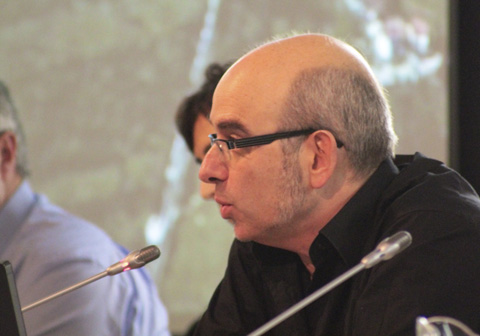Ander de la Fuente, architect and author of the thesis entitled 'Pautas para un protocolo de identificación, valoración, intervención y socialización de paisajes' (Guidelines for a protocol to identify, evaluate, intervene in and socialise landscapes) analyses the sense of belonging of social groups to the places they inhabit as a basis for transforming the landscape they occupy.
Collective memory essential in landscape recovery
A researcher at the UPV/EHU-University of the Basque Country has come up with a method to analyse landscapes from a triple perspective: as memory, as perceived image and as a sociosystem
First publication date: 24/06/2015

"We're not talking about cultural, or urban or natural landscapes," points out the author. "The thesis is about a method for analysing any anthropized landscape. What we understand by anthropized landscape is one that has been shaped by human beings, like the majority in our area; although some don't look as if they have been altered very much, in actual fact they all bear the stamp of their use, of the domination of the territory down the centuries," he added.
The landscape "is memory, an accumulation of reminiscences, with a specific symbolism for the citizens; it is a perception, an image, a reference in the everyday lives of the inhabitants in the area, which also leaves an imprint on visitors; and it is also a ‘sociosystem', a space in which human activities take place, a source of resources and, at the same time, a habitat for the population". So the study of these built landscapes should not be tackled by classifying them into homogeneous areas, but by identifying within them places with a special character and with their own dynamics.
The method being proposed by De la Fuente is as follows: "We identify the areas or zones with unique dynamics (the so-called "structuring subsystems of the territory'), which are in fact the cells or neurons whose interconnection provides us with an X-ray of the landscape we want to analyse. After that, the elements characterising these areas are evaluated by using comparable indicators and comparing the knowledge available on the subject with the social perception. Finally, guidelines for intervention are proposed to restore the heritage assets and incorporate them as a scenario and symbol of narratives; to ‘stitch together' the discontinuities that hamper their perception within a coherent image, and to design management models enabling the socio-economic revitalisation of the territory to be made".
Land-use planning
So it is about "going further and proposing as an aim an intervention that entails the recovery of these landscapes on the basis of memory, which is in fact the core of the thesis. Naturally, socialisation is fundamental: memory is a social construction, and it is society that decides what forms part of its memory or what does not and, therefore, what heritage is," points out the architect.
However, as the author himself says, "that constructed memory is changeable and therefore can be modified. And so can the perceived image that can be used as a scenario. And if we find new meaning in the social perception and memory of a landscape, we will be able to plan it to turn it into a space for the socioeconomic development of those who are able to identify with it".
According to De la Fuente, "analysing the 'sociosystem' also enables one to establish some specific lines for managing that economy and that society that are linked to a shared memory, which allows us to do something very important: to plan the space on the basis of identity".
Additional information:
PhD thesis (Pautas para un protocolo de identificación, valoración, intervención y socialización de paisajes) written up in 2014 and supervised by Agustín Azkarate Garai-Olaun, an UPV/EHU professor and doctor.

